
Batch QC allows you to rapidly address large data sets with many records. You can run Batch QC on an entire service layer or an existing queue. It is a tool designed to save you time. For example, if you have a thousand lines to address, you may not have time to manually address all of them. Let Batch QC do the work of automatically snapping your lines to flowlines within the snap tolerance. Then you can manually inspect only those lines that did not automatically snap.
If your data has been previously been addressed and already has a ReachCode or GNIS_NAME, HydroAdd will snap it to the flowline with a matching ReachCode or GNIS_NAME. Batch QC prioritizes ReachCode over GNIS_NAME but can use either. For example, you may have line events that have previously been addressed to the NHDPlus V2. Batch QC will snap the line events to a matching ReachCode in the NHD, if it is within the snap tolerance.
Batch QC results reside on the HydroAdd application server—your data are not updated to AGOL until you publish. Results of Batch QC jobs are always available in the Batch QC queue--even after you publish or remove the corresponding service layer from AGOL. You should always review the results of Batch QC before you publish the results to your service layer on AGOL. This acts as a safeguard to protect your data because it allows to you to try different snap tolerances before you publish. You cannot undo the edits to your service layer once HydroAdd publishes the updates. In any case, you should always keep a copy of your original data and ArcGIS Pro project.
The Batch QC panes lists all the batch jobs you have run. You can filter the jobs list by date range, or sort by created/completed date. The Batch QC results listed in the Batch QC Pane reside on the HydroAdd application server—your data are not updated to AGOL until you publish. Results of Batch QC jobs are always available in the Batch QC pane--even after you publish or remove the corresponding service layer from AGOL.




See also HydroAdd Line Schema.
See also Lines Batch QC Logic.
User input. The maximum distance you allow Batch QC to move both start and end points of a line event. Snap tolerance is essentially a buffer around the start and end points. If there is a flowline feature within the snap tolerance of both start and end points, Batch QC will snap the points, then draw a line event connecting the points. Both start and end points must be in snap tolerance for HydroAdd to draw a new line event. If one of the points is not in snap tolerance, HydroAdd will not draw a new line event.
See also HydroAdd Line Schema.
See also Lines Batch QC Logic.
User input. The maximum snap distance where both start and end points of a line event are automatically approved. If there is a flowline feature within the snap tolerance of both start and end points, Batch QC will snap the points, then draw a line event connecting the points. However, automatic approval by Batch QC depends on the QC tolerance. If the snap distance is greater than the QC tolerance, then the lines is not approved.
Tips for setting QC tolerance
User input. Percent length change acceptable during batch QC. HydroAdd splits lines at ReachCodes. A single long line event may be split into several shorter line events--one on each ReachCode. Length Change is the percent length change of newly addressed line from original input line.
Length Change Tolerance is useful for finding very short line events produced by Batch QC. For example, an original line event may be split into several shorter line events during Batch QC--one on each ReachCode. Sometimes the the original line event overlaps a short segment of an adjacent ReachCode. The most common place to find such short segments is on tributaries to the main stem or at confluences where two or more ReachCodes meet. Compared to the original line event, these short segments have large percent length change, usually greater than 80%.
To find very short segments during QC, set the Length Change Tolerance high, up to 80-90%. New line events with Length Change less than the Length Change Tolerance are approved, but very short segments where the Length Change is greater than Length Change Tolerance are not approved.
To QC line events by Snap Distance alone, set Length Change Tolerance to 100%. All lengths of new line events are thus approved, and QC approval status depends solely on QC Tolerance.
See also HydroAdd Line Schema.
See also Lines Batch QC Logic.
The Lines Batch QC Job Status shows:

The Batch QC Review Queue allows you to review the Batch QC results before you publish to AGOL. Batch QC results reside on the HydroAdd application server—your data are not updated to AGOL until you publish. Results of Batch QC jobs are always available in the Batch QC pane—even after you publish or remove the corresponding service layer from AGOL. You should always review the results of Batch QC before you publish the results to your service layer on AGOL. This acts as a safeguard to protect your data because it allows to you to try different tolerances before you publish. You cannot undo the edits to your data once HydroAdd publishes the updates. In any case, you should always keep a copy of your original data and ArcGIS Pro project.
Batch QC splits very long line events into several shorter line events--one on each ReachCode. The Batch QC queue displays these shorter segments as a line group under the original. You may find that some of these shorter segments are not approved, even if they are in the right place. This is likely because the shorter segments are outside the Length Change Tolerance. Compared to the original line event, these short segments have large percent length change. To find very short segments during QC, set the Length Change Tolerance high, up to 80-90%.
See also Tips for lines Batch QC.
Click a row in the Batch QC queue to zoom to the feature.
Hover the cursor over a row to highlight features yellow.
Original features are cyan.
Results are red.
Queues are paginated. You can choose the number of rows per page.

You can see details of the Batch QC for each feature.


See also HydroAdd Line Schema.
See also Lines Batch QC Logic.
Publishing from HydroAdd updates the features in your service layer at AGOL. However, the results displayed in the Batch QC queue do not change after publishing. The results are essentially a static snapshot of the state of your service layer before publishing. Even when the features in the map update to new locations after publishing, results of Batch QC queue remain unchanged.
You can always run Batch QC again after publishing, but you will get different results because publishing overwrites your service layer—many of the feature will have been addressed to flowlines. To see the actual approval status of the features after publishing, you must examine the features in an editing queue (not the Batch QC queue) or use the identify tool in the map.
NOTE: Only published lines can be added to editing queues. This is because Batch QC results reside only on the HydroAdd application server—they are virtual objects, not real features in your service layer. Your data are not updated to AGOL until you publish. However, only "real" line features with geometry can be added to queues. Points do not have this limitation because their geometry is simple; unpublished points can be added to editing queues.






Publishing from HydroAdd updates the features in your service layer at AGOL. However, the results displayed in the Batch QC queue do not change after publishing. The results are essentially a static snapshot of the state of your service layer before publishing. Even when the features in the map update to new locations after publishing, results of Batch QC queue remain unchanged.
You can always run Batch QC again after publishing, but you will get different results because publishing overwrites your service layer—many of the feature will have been addressed to flowlines. To see the actual approval status of the features after publishing, you must examine the features in an editing queue (not the Batch QC queue) or use the identify tool in the map.

To publish multiple lines

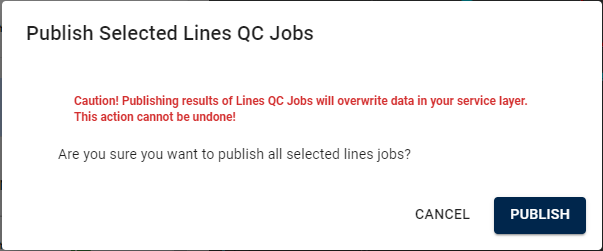



See also Tips for lines Batch QC.
See also HydroAdd Line Schema.
See also Lines Batch QC Logic.
The publishing status of the entire job is displayed with job statistics in the list of all Batch QC jobs.
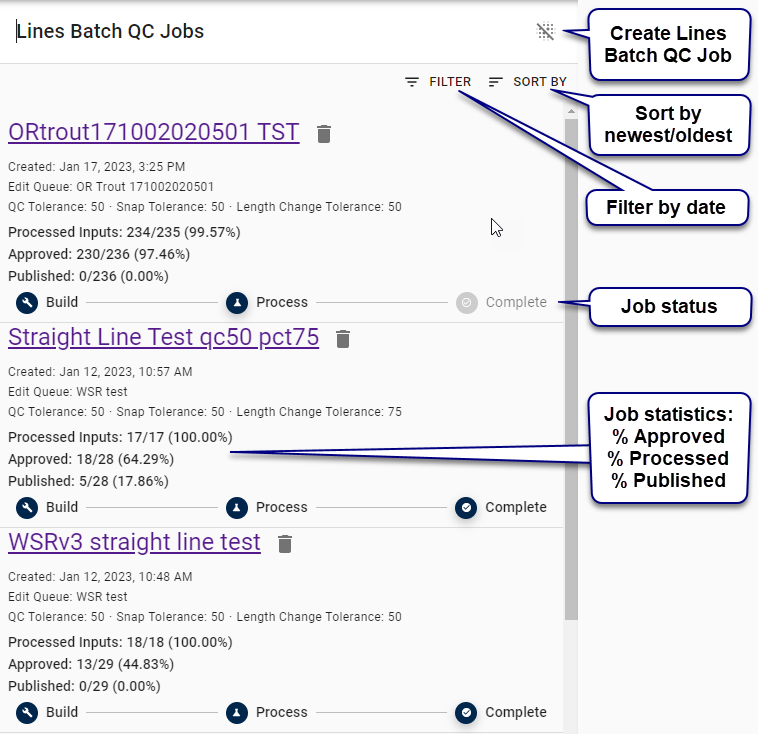
The publishing status of individual features is always shown in the Batch QC queue:
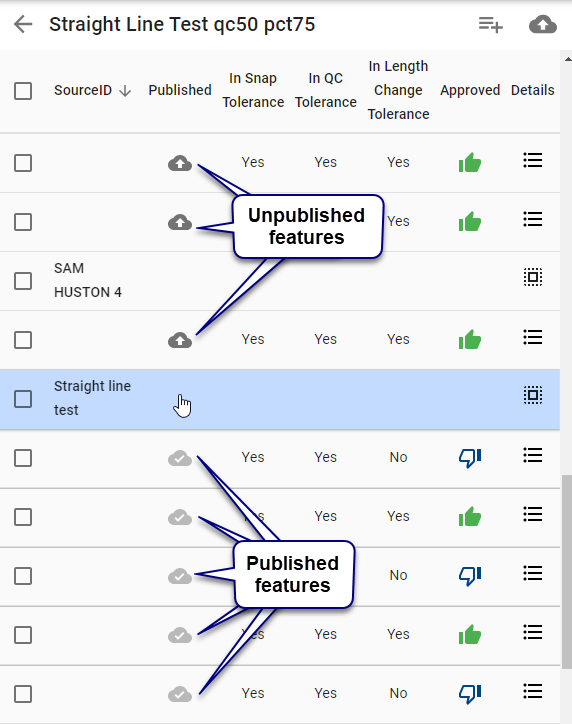
You can add selected lines to editing queues. NOTE: Only published lines can be added to editing queues. This is because Batch QC results reside only on the HydroAdd application server—they are virtual objects, not real features in your service layer. Your data are not updated to AGOL until you publish. However, only "real" line features with geometry can be added to queues. Points do not have this limitation because their geometry is simple; unpublished points can be added to editing queues.
Because only published lines can be added to queues, best practice is to publish all lines, even unapproved lines. Once publishing is complete, add the unapproved lines to an editing queue for manual inspection.
Select a line group, or select all rows.
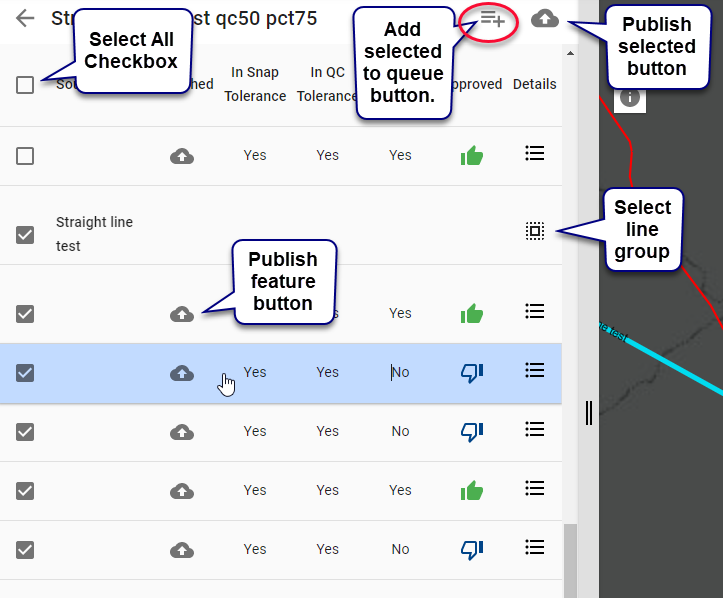
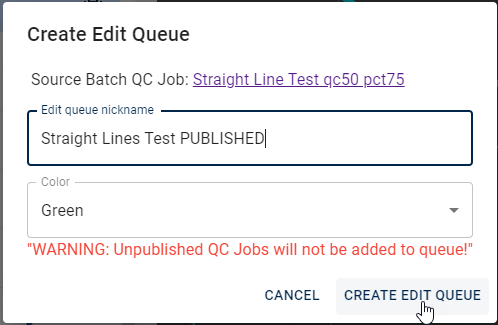

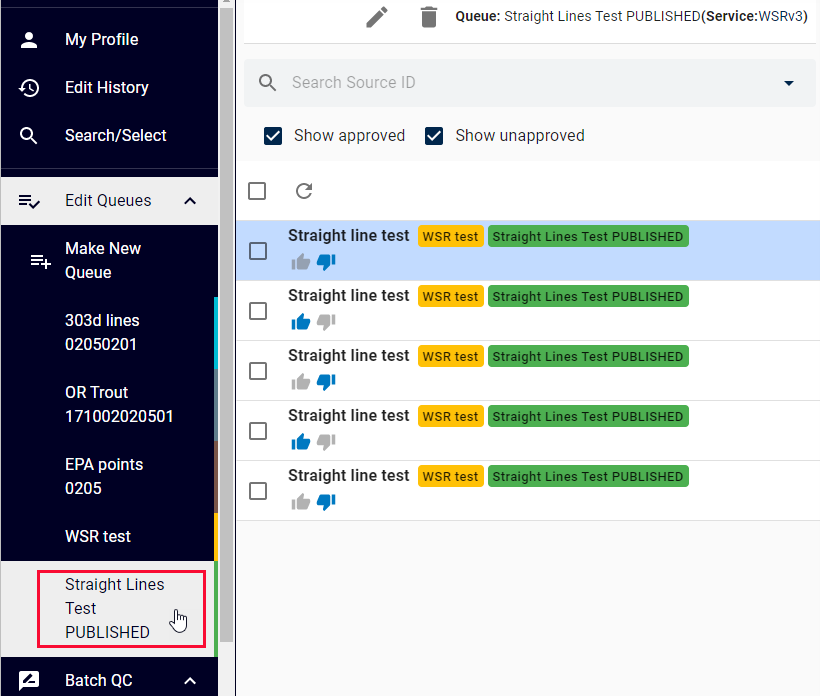
Overview of Lines Batch QC Logic. Note that InSnapTolerace refers to both start and end points of the line.
| InSnapTolerance | InQCTolerance | InLengthTolerance | QCApproved | Batch QC detail message |
| NO | NO | NO | NO | Not approved: Start or end point is not in Snap Tolerance. |
| YES | NO | NO | NO | Not approved: Start or end point is equidistant from two or more flowlines. |
| YES | NO | NO | NO | Not approved: Start or end point is not in QC tolerance; Line is not in length change tolerance. |
| YES | YES | NO | NO | Not approved: Line is not in length change tolerance. |
| YES | NO | YES | NO | Not approved: Start or end point is not in QC tolerance. |
| YES | YES | YES | YES | Approved: Both start and end points are in QC tolerance; Line is in length change tolerance. |